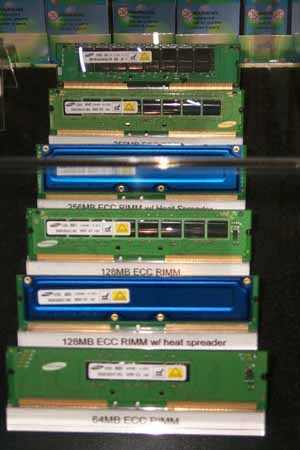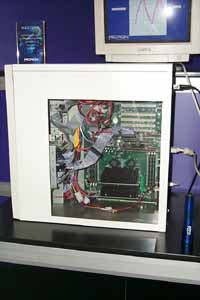Intel IDF Report #4 - Wrap Up
by Mike Andrawes on February 29, 2000 3:15 AM EST- Posted in
- Trade Shows
 In
part 4 of our IDF coverage, we wrap things up and take a look at some of the
miscellaneous items that we saw down in Palm Springs. We didn't mention it earlier,
but the weather in Palm Springs was absolutely gorgeous. It's a shame that IDF
is moving away from Palm Springs, but hopefully the next spot will be just as
pleasant.
In
part 4 of our IDF coverage, we wrap things up and take a look at some of the
miscellaneous items that we saw down in Palm Springs. We didn't mention it earlier,
but the weather in Palm Springs was absolutely gorgeous. It's a shame that IDF
is moving away from Palm Springs, but hopefully the next spot will be just as
pleasant.
Memory Roadmap Overview
Intel made it clear time and time again that RDRAM is the primary memory technology for the future. In the desktop segment, they expect RDRAM to fill the mainstream desktop market by the end of 2000 and transition to the value segment by early 2001.
They believe that since the pin count for RDRAM is reduced compared to SDRAM, they can double the bandwidth easily. Whether this doubling in bandwidth is achieved by doubling the number of RDRAM channel, by increasing the clock, or by using a quad pumped data transfer mechanism was unclear in the presentation, but the first option seems the most likely. As mentioned in our first IDF report, the initial Tahema chipset for the Willamette processor will be RDRAM only, with support for two channels to help satiate that "400 MHz" bus.
The workstation space, where memory performance is critical, is also transitioning rapidly to RDRAM under the i840 chipset. The "2+2" configuration, meaning 2 RIMM + 2 DIMM slots, of the i820 chipset is now officially supported by Intel. Look for a number of motherboards to start popping up from virtually every manufacturer with this support. Intel did claim the difficulties they ran into with 3 RIMM's and the i820 is not unsolvable, but since current OEM's are not complaining about the 2 RIMM situation, they see little reason to play around with what works.
According to Intel, as the processor performance increases, the benefits experienced from RDRAM will increase as well. The figures they gave us now indicate a 2 - 5% benefit from RDRAM now, and they predict that as the performance of CPUs increase that figure could increase to 30%. They don't see a role for DDR SDRAM in the desktop market, which is very unfortunate, at least for the time being.
SDRAM support will continue on in the value desktop and mobile segments as well. The i815 chipset, code named Solano, will finally provide a solution to the desktop market with 133 MHz FSB, PC133 SDRAM, AGP 4x, and UDMA/66 support from an Intel chipset. Up until now, the only option for all these features has been the VIA Apollo Pro 133A. A new ICH should be introduced with the i815 as well that will include USB 2.0 support. This ICH will be used in conjunction with the i820's current MCH to produce the i820E. The i815 will have an integrated graphics core that is virtually identical to that of the i810/i810E, but also add an external AGP 4x port for upgraded graphics. While most AnandTech readers will disable the onboard graphics for any high performance rig, the onboard graphics could still come in handy for use with a second monitor. Look for the i815 in late Q2 2000.
Since there is a huge cost premium associated with RDRAM at the moment, Intel is looking to support SDRAM and DDR SDRAM on its server platforms in 2001. The problems they see, however, is that while a single chipset can support both SDRAM and DDR SDRAM, motherboard PCB layout and memory socket requirement are different between the two memory technologies, which makes the migration path difficult. Obviously, AMD and VIA think differently, so we'll see just how they deal with those issues when the release their DDR enabled chipsets later this year.
With Intel still firmly pushing RDRAM as the primary memory solution for the future, we weren't the least bit surprised to see RDRAM modules all over the show floor from every memory manufacturer. Here's a few thousand dollars worth of RDRAM at the Samsung booth:













0 Comments
View All Comments